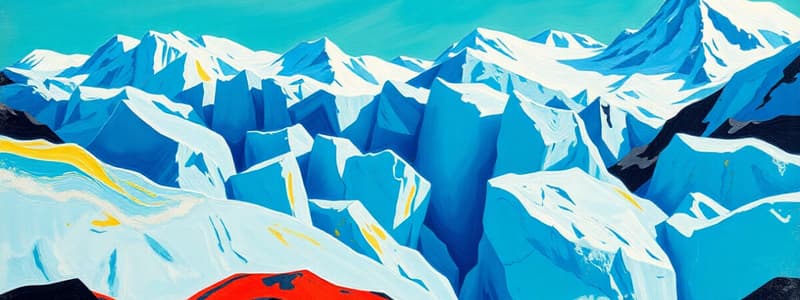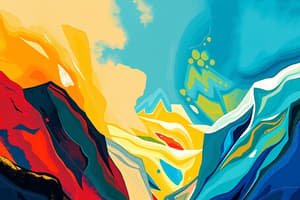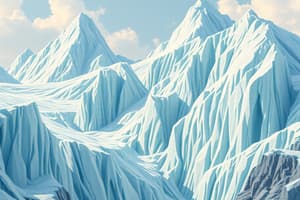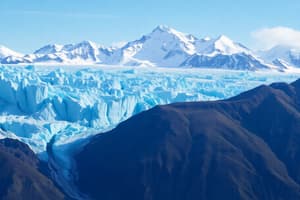Podcast
Questions and Answers
Which of the following statements accurately describes the cryosphere's influence on Earth's climate?
Which of the following statements accurately describes the cryosphere's influence on Earth's climate?
- The cryosphere's highly reflective surface bounces sunlight back into space, reducing surface air temperature and playing a crucial role in global temperature regulation. (correct)
- The cryosphere primarily absorbs solar radiation, leading to a localized warming effect that accelerates ice melt.
- The cryosphere's highly reflective surfaces primarily absorb solar radiation, leading to global warming.
- The cryosphere has minimal impact on global temperature regulation due to its limited surface area.
How does the accumulation of snow contribute to the formation of glaciers and ice caps?
How does the accumulation of snow contribute to the formation of glaciers and ice caps?
- Snow accumulation directly transforms into glacial ice through a rapid freezing process, requiring minimal compaction.
- Snow accumulation prevents the formation of glaciers and ice caps due to its loose structure.
- The accumulation of snowfall, when exceeding seasonal melt, compacts over time, increasing density and eventually forming glaciers and ice caps. (correct)
- Snow accumulation that melts seasonally is the primary contributor to glacier and ice cap formation.
What distinguishes a valley glacier from a cirque glacier?
What distinguishes a valley glacier from a cirque glacier?
- A valley glacier is a glacier in a fjord, while a cirque glacier spreads out from a valley glacier.
- A valley glacier is found in high mountain ranges, while a cirque glacier is located in low-lying areas.
- A valley glacier is the smallest type of glacier, while a cirque glacier extends down from a valley.
- A valley glacier extends down from a cirque, while a cirque glacier is the smallest type of glacier. (correct)
What is the primary mechanism by which glaciers move?
What is the primary mechanism by which glaciers move?
How does the density of glacial ice contribute to its unique properties, distinguishing it from regular snow?
How does the density of glacial ice contribute to its unique properties, distinguishing it from regular snow?
How do ice grains within a glacier change with depth, and what implications does this have for the glacier's structure?
How do ice grains within a glacier change with depth, and what implications does this have for the glacier's structure?
What critical factor determines whether a glacier is classified as warm (temperate) or cold (polar)?
What critical factor determines whether a glacier is classified as warm (temperate) or cold (polar)?
A research team discovers a massive ice formation covering a highland area that flows radially outward. Considering its characteristics, which type of glacier is most likely observed?
A research team discovers a massive ice formation covering a highland area that flows radially outward. Considering its characteristics, which type of glacier is most likely observed?
If a region experiences consistent snow accumulation exceeding seasonal melt, what long-term effect would this likely have on local glacial formations?
If a region experiences consistent snow accumulation exceeding seasonal melt, what long-term effect would this likely have on local glacial formations?
How do continent-sized ice sheets, like those in Greenland and Antarctica, influence global sea levels, and what percentage of Earth's glaciers do they represent?
How do continent-sized ice sheets, like those in Greenland and Antarctica, influence global sea levels, and what percentage of Earth's glaciers do they represent?
How does the principle of 'mass balance' most directly govern glacial dynamics?
How does the principle of 'mass balance' most directly govern glacial dynamics?
Considering the process of glacier ice movement, what role do individual ice crystals play in internal flow?
Considering the process of glacier ice movement, what role do individual ice crystals play in internal flow?
What is the most accurate explanation for why the uppermost ice in the central part of a glacier flows faster than the ice at the sides and base?
What is the most accurate explanation for why the uppermost ice in the central part of a glacier flows faster than the ice at the sides and base?
How would a decrease in accumulation relative to ablation affect the terminus of a glacier over time?
How would a decrease in accumulation relative to ablation affect the terminus of a glacier over time?
What implications does the 'response lag' have for predicting the future behavior of a glacier given changes in accumulation?
What implications does the 'response lag' have for predicting the future behavior of a glacier given changes in accumulation?
What is the primary distinction between coastal glacier retreat via frontal calving and the behavior of fjord glacier termini?
What is the primary distinction between coastal glacier retreat via frontal calving and the behavior of fjord glacier termini?
How would you differentiate between the effects of glacial plucking versus glacial abrasion on the landscape?
How would you differentiate between the effects of glacial plucking versus glacial abrasion on the landscape?
How does the viscosity of glacial ice influence the sorting and stratification of glacial deposits?
How does the viscosity of glacial ice influence the sorting and stratification of glacial deposits?
Assuming the Earth continues to fluctuate between glacial and interglacial periods, what are the expected long-term consequences on global sea levels?
Assuming the Earth continues to fluctuate between glacial and interglacial periods, what are the expected long-term consequences on global sea levels?
How does the presence of 'rock flour' contribute to the unique characteristics of glacially polished bedrock surfaces?
How does the presence of 'rock flour' contribute to the unique characteristics of glacially polished bedrock surfaces?
How does the process of sea ice formation influence the salinity of the surrounding ocean water, and what implications does this have for marine ecosystems?
How does the process of sea ice formation influence the salinity of the surrounding ocean water, and what implications does this have for marine ecosystems?
Considering the cyclical nature of glacial and interglacial periods, how do changes in sea ice extent and volume contribute to long-term variations in global sea levels?
Considering the cyclical nature of glacial and interglacial periods, how do changes in sea ice extent and volume contribute to long-term variations in global sea levels?
How might the presence of patterned ground in periglacial regions affect local hydrological systems and infrastructure stability?
How might the presence of patterned ground in periglacial regions affect local hydrological systems and infrastructure stability?
What feedback mechanisms are initiated by the thawing of the active layer in periglacial environments, and how do these amplify the effects of climate change?
What feedback mechanisms are initiated by the thawing of the active layer in periglacial environments, and how do these amplify the effects of climate change?
In the context of glacial debris deposition, how would you distinguish between the formation processes and resulting sediment characteristics of 'till' versus 'outwash'?
In the context of glacial debris deposition, how would you distinguish between the formation processes and resulting sediment characteristics of 'till' versus 'outwash'?
How do cirques and arêtes, sculpted by glacial erosion, influence the patterns of subsequent erosion and sediment transport in mountainous regions?
How do cirques and arêtes, sculpted by glacial erosion, influence the patterns of subsequent erosion and sediment transport in mountainous regions?
How can the analysis of ice cores from valley glaciers provide insights into past environmental conditions that might not be obtainable from ice cores extracted from large ice sheets?
How can the analysis of ice cores from valley glaciers provide insights into past environmental conditions that might not be obtainable from ice cores extracted from large ice sheets?
What would be the long-term effects on regional geomorphology if gelifluction rates significantly increased in periglacial regions due to climate change?
What would be the long-term effects on regional geomorphology if gelifluction rates significantly increased in periglacial regions due to climate change?
How do fjords, formed by glacial erosion, influence present-day oceanographic processes compared to river-carved estuaries in coastal regions?
How do fjords, formed by glacial erosion, influence present-day oceanographic processes compared to river-carved estuaries in coastal regions?
Considering the implications for climate modeling, how does the relatively small volume of sea ice compared to its extensive surface area affect its role in regulating global temperatures?
Considering the implications for climate modeling, how does the relatively small volume of sea ice compared to its extensive surface area affect its role in regulating global temperatures?
How does the formation of sea ice contribute to the creation of deep bottom ocean water?
How does the formation of sea ice contribute to the creation of deep bottom ocean water?
What is the immediate effect of floating ice on the exchange of heat between the ocean surface and the atmosphere?
What is the immediate effect of floating ice on the exchange of heat between the ocean surface and the atmosphere?
What mechanism primarily drives atmospheric circulation as a direct result of the presence of sea ice?
What mechanism primarily drives atmospheric circulation as a direct result of the presence of sea ice?
If the Earth were to undergo a significant climate cooling, leading to expanded ice cover, what primary feedback mechanism would be initiated?
If the Earth were to undergo a significant climate cooling, leading to expanded ice cover, what primary feedback mechanism would be initiated?
Why would the melting of land ice have a more substantial impact on global sea levels compared to the melting of sea ice?
Why would the melting of land ice have a more substantial impact on global sea levels compared to the melting of sea ice?
How does the presence of sea ice influence the ocean's ability to absorb atmospheric carbon dioxide?
How does the presence of sea ice influence the ocean's ability to absorb atmospheric carbon dioxide?
What role does the constant motion and changing nature of sea ice play in global climate regulation?
What role does the constant motion and changing nature of sea ice play in global climate regulation?
Considering the distribution of sea ice in both hemispheres, how does the geography affect the form and stability of sea ice coverage?
Considering the distribution of sea ice in both hemispheres, how does the geography affect the form and stability of sea ice coverage?
If global temperatures continue to rise, what are the compounded effects of reduced summer sea ice on polar and global climate patterns?
If global temperatures continue to rise, what are the compounded effects of reduced summer sea ice on polar and global climate patterns?
Initially, how does sea ice form when ocean surface temperatures drop to the freezing point of seawater?
Initially, how does sea ice form when ocean surface temperatures drop to the freezing point of seawater?
Flashcards
What is the cryosphere?
What is the cryosphere?
The part of Earth's surface that remains perennially frozen.
How much of Earth's land surface do glaciers and frozen ground cover?
How much of Earth's land surface do glaciers and frozen ground cover?
Glaciers: 10%, Frozen ground: 20%
Glacier Formation
Glacier Formation
Snowfall accumulation exceeding seasonal melt contributes to glacier and ice cap formation.
What is a glacier?
What is a glacier?
Signup and view all the flashcards
What is a cirque glacier?
What is a cirque glacier?
Signup and view all the flashcards
What is a valley glacier?
What is a valley glacier?
Signup and view all the flashcards
Glacier system scale
Glacier system scale
Signup and view all the flashcards
What are ice sheets?
What are ice sheets?
Signup and view all the flashcards
Significance of Greenland & Antarctica Ice Sheets
Significance of Greenland & Antarctica Ice Sheets
Signup and view all the flashcards
What is the temperatures difference between warm and cold glaciers?
What is the temperatures difference between warm and cold glaciers?
Signup and view all the flashcards
Glacier advance or retreat
Glacier advance or retreat
Signup and view all the flashcards
Accumulation area
Accumulation area
Signup and view all the flashcards
Ablation area
Ablation area
Signup and view all the flashcards
Equilibrium Line
Equilibrium Line
Signup and view all the flashcards
Terminus
Terminus
Signup and view all the flashcards
Mass balance
Mass balance
Signup and view all the flashcards
Internal flow
Internal flow
Signup and view all the flashcards
Basal sliding
Basal sliding
Signup and view all the flashcards
Response lag
Response lag
Signup and view all the flashcards
Frontal calving
Frontal calving
Signup and view all the flashcards
Periglacial regions
Periglacial regions
Signup and view all the flashcards
Permafrost
Permafrost
Signup and view all the flashcards
Patterned ground
Patterned ground
Signup and view all the flashcards
Pingoes
Pingoes
Signup and view all the flashcards
Moraines
Moraines
Signup and view all the flashcards
Esker
Esker
Signup and view all the flashcards
Kettle
Kettle
Signup and view all the flashcards
Till
Till
Signup and view all the flashcards
Outwash
Outwash
Signup and view all the flashcards
Formation of Sea ice
Formation of Sea ice
Signup and view all the flashcards
Frazil Ice
Frazil Ice
Signup and view all the flashcards
Sea Water Freezing Point
Sea Water Freezing Point
Signup and view all the flashcards
Sea Ice Distribution
Sea Ice Distribution
Signup and view all the flashcards
Sea Ice & Ocean Salinity
Sea Ice & Ocean Salinity
Signup and view all the flashcards
Dense Saline Water Production
Dense Saline Water Production
Signup and view all the flashcards
Ice Isolation Effect
Ice Isolation Effect
Signup and view all the flashcards
Albedo Effect on Atmospheric Circulation
Albedo Effect on Atmospheric Circulation
Signup and view all the flashcards
Study Notes
- The cryosphere is the part of Earth's surface that remains perennially frozen.
- Sea ice, glaciers, and frozen ground are components of the cryosphere.
- Glaciers cover 10% of Earth's land surface.
- Frozen ground constitutes 20% of Earth's land.
- Almost 1/4 of the land in the Northern Hemisphere is covered by snow and frozen ground during the winter.
- The accumulation of snowfall greater than seasonal melt is a primary factor in glacier and ice cap formation.
- Highly reflective surfaces bounce sunlight back into space, which reduces surface air temperature.
Glaciers
- A glacier's advance or retreat depends on the balance between accumulation and ablation.
- Accumulation refers to added snow and ice.
- Ablation refers to lost snow and ice.
- The upper zone of a glacier is the accumulation area.
- The ablation area is below the accumulation area.
- The equilibrium line separates the accumulation and ablation areas.
- The terminus is the front of the glacier.
- The terminus responds to changes in mass balance.
- Glacial ice moves via internal flow and basal sliding.
- Internal flow happens when ice at critical thickness deforms and moves downslope due to gravity.
- Glacial ice deforms within individual ice crystals under stress.
- The surface is brittle, forming crevasses under tension to depths of <50 m.
- Glaciers form when gravity pulls a thick mass of snow and ice, causing it to move.
- Cirque glacier: The smallest glacier type.
- Valley glacier: A glacier extends down from a cirque.
- Ice cap: These cover mountain highlands or low-lying land at high latitudes and flow outward radially.
- Fjord glacier: A glacier located in a fjord.
- Piedmont glacier: A glacier that spreads out from a valley glacier.
- Earth's high mountain ranges contain glacier systems that extend tens of kilometers.
- Continent-sized ice sheets overwhelm land within their margins.
- Greenland and Antarctica hold 95% of Earth's glaciers.
- Glaciers in Greenland and Antarctica can reach 3000 m thick.
- Ice shelves, hundreds of meters thick, are in Antarctica's embayments.
- Glaciers originate from accumulated snow that is compacted until it has a density that prevents air from penetrating.
- Glacier ice is classified as a rock.
- Ice grains recrystallize at depth within glaciers, growing to 1 cm near the base.
- Glaciers can form wherever snow and ice have the ability to accumulate.
- High latitudes and high mountains at low latitudes are common.
- Ice temperatures vary among different glaciers.
- Warm (temperate) glaciers exist at the pressure melting point and can coexist with water.
- Cold (polar) glaciers are below the pressure melting point.
Glaciation
- Glacial erosion sculpts landforms such as cirques, aretes, U-shaped valleys, fjords and drumlins.
- Glaciers carry debris that is eventually deposited.
- Till is unsorted glacial debris that is deposited by glacial ice.
- Outwash is debris that is reworked, transported, and deposited by meltwater.
- Moraines are glacially bulldozed ridges of sediment.
- Eskers are curved ridges of sand and gravel.
- Kettles are closed basins.
- Land beyond the limit of glaciers is called periglacial and is mainly found in circumpolar regions.
- Periglacial regions are characterized by permafrost.
- The active layer of permafrost thaws in summer, becomes unstable, and refreezes in winter.
- When the active layer melts, the ground collapses.
- Patterned ground refers to ice-wedge polygons.
- Pingoes are frost-heaved hills.
- Gelifluction is mass wasting.
- Evidence of local and global environmental conditions is trapped in the snow that accumulates each year on a glacier.
- The oldest ice in most cirque and valley glaciers is several hundred to several thousand years old.
- Large ice sheets contain ice that dates far back into the ice ages.
- This can be examined through ice cores.
Sea Ice
- Sea ice forms by the solidification of fresh water at the ocean surface.
- Sea ice formation is not due to precipitation.
- Salt crystals are excluded during sea ice formation.
- Oceans become saltier in glacial periods and less salty when sea ice melts.
- Two thirds of Earth's persistent ice cover floats as a thin veneer on polar oceans.
- Sea ice comprises 1/1000 of Earth's total ice volume.
- When the ocean surface cools to the freezing point of sea water, additional cooling forms ice.
- Frazil refers to the first small platelets or needles that form.
- After frazil a soupy mixture forms at the surface.
- Without waves, crystals freeze together as a 1-10 cm thick ice blanket.
- With waves, crystals form 3 cm diameter pancake-like ice masses.
- Sea ice is distributed differently between the two hemispheres due to geography.
- Antarctica is covered by a vast, thick ice sheet, with sea ice forming a ring around it.
- The North Pole is within the deep Arctic Ocean, which is mostly covered by sea ice.
- Sea ice is in constant motion and constantly changing.
- Interactions among ice, water, and atmosphere influence ocean structure, salinity, and circulation.
- Sea ice is sensitive to temperature change.
- Salt exclusion during sea ice formation leads to the production of dense, cold saline water on the continental shelves.
- This production of dense, cold saline water produces deep-bottom ocean water.
- Floating ice isolates the ocean surface from the atmosphere, cutting off heat exchange.
- Ice has high albedo, reflecting incoming solar radiation rather than absorbing it.
- This results in a steep temperature gradient between the equator and poles, which drives atmospheric circulation.
- If the climate became colder and ice expanded, the result is a positive feedback due to raised albedo.
- If the climate warms and ice shrinks, a similar but opposite effect of positive warming occurs as overall albedo decreases.
- Melting sea ice doesn't contribute much to ocean levels, but melting land ice contributes a lot to water volume.
- Melting sea ice and land ice would drastically affect ocean salinity.
Studying That Suits You
Use AI to generate personalized quizzes and flashcards to suit your learning preferences.




